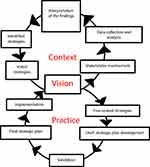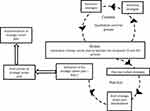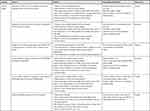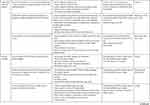Back to Journals » HIV/AIDS - Research and Palliative Care » Volume 14
A Strategic Action Plan to Improve an Integrated Family Planning and HIV Service: Using Multiple Nominal Groups to Ensure Stakeholder Involvement
Authors Mekonnen DA , Roets L
Received 5 April 2022
Accepted for publication 25 August 2022
Published 15 September 2022 Volume 2022:14 Pages 423—435
DOI https://doi.org/10.2147/HIV.S369429
Checked for plagiarism Yes
Review by Single anonymous peer review
Peer reviewer comments 2
Editor who approved publication: Prof. Dr. Olubunmi Akindele Ogunrin
Dessie Ayalew Mekonnen,1 Lizeth Roets2
1Department of Health Studies, College of Human Sciences, University of South Africa, Addis Ababa, Ethiopia; 2Department of Health Studies, College of Human Sciences, University of South Africa, Pretoria, South Africa
Correspondence: Dessie Ayalew Mekonnen, Department of Health Studies, College of Human Sciences, University of South Africa, Addis Ababa, Ethiopia, Tel +251911746975, Email [email protected]
Introduction: The World Health Organization recommends that family planning be integrated in HIV services, to improve service offering and uptake; stakeholder involvement is crucial. The purpose of this manuscript is to share the utilization of nominal group technique (NGT) and multiple group analysis as a vehicle to ensure stakeholder involvement in the development of a strategic action plan to improve the implementation of integrated services in Ethiopia.
Methods: A qualitative research design, employing a NGT, was applied as data-gathering method to develop a strategic action plan for facilitating the integration of family planning and HIV services. NGT was used to ensure the equal involvement of stakeholders in the development thereof. Twenty-four programme managers in Addis Ababa, Ethiopia – experts in family planning and HIV/AIDS programmes, working in 10 sub-city health departments – participated in the nominal groups to identify the strategies to be included in an action plan development to facilitate integrated services.
Results: The first nominal group’s participants identified 12 themes, derived from the 21 categories generated from 34 individual ideas. The second group identified nine themes, from 16 categories, generated from 30 individually ideas. A multiple group analysis utilizing the findings from both groups revealed the top five most important themes (leadership and management, capacity building, implementing policies and guidelines, advocacy/awareness and infrastructure) that were selected to be included in a strategic action plan to integrated family planning and HIV services in Ethiopia.
Discussion: The strategic action plan developed by the researcher who took into account the findings from the multiple group analysis was validated in a face-to-face validation meeting by all the relevant stakeholder’s participation. Stakeholder involvement, utilizing different nominal groups and conducting multiple nominal group analysis ensured ownership of the strategic action plan as those involved in the development, will be the individuals to implement in Ethiopia.
Keywords: strategic action plan, nominal group technique, stakeholder involvement
Background
The World Health Organization (WHO) recommends family planning be integrated in HIV services, to improve both the service offering and its uptake.1 It is evident that where such integration is available at the facility level, it is useful for delivering both family planning and HIV services effectively in sub-Saharan African countries.2 Integrated family planning and HIV services are offered in Ethiopia, although not to the extent as required by Ministry of Health and stakeholders.13 One of the factors contributing to the successful integration of family planning and HIV services is the development of a comprehensive strategic action plan3 and not only desktop reviews and consultations.14
A strategic action plan, a useful tool for successfully implementing any intervention, guideline or policy, can be defined as a recognised set of activities or broad plans of action which serve to achieve a specific goal,4 the purpose of such a plan being to determine where and what is required to achieve the desired outcomes.5 Specific actions need to be formulated and taken, to achieve longer-term goals. Stakeholder engagement has a major impact on the development and success of any strategic action plan, and the operationalisation thereof.5 For that reason, it is vital that the relevant stakeholders be involved, as they are the ultimate actors driving the implementation of the plan.5
Stakeholders operating in the context of family planning and HIV services were involved in the development of a strategic action plan in Ethiopia. The process planning model, as modified by Lubbe and Roets (2014), was used to guide the multiple nominal group data analysis process in the course of developing a strategic action plan to facilitate the implementation of integrated family planning and HIV services.6 This study reflects and share how more than one nominal group, with a multiple group analysis to combine and prioritize the findings of all groups, can be useful in the development of a strategic action plan to ensure equal participation and a voice to every individual stakeholder who participates. This method can be beneficial and very effective to be added to existing practices of desk reviews and consultative meetings in Ethiopia.
The Aim
The aim of this article is to share the results of stakeholder involvement in the development of a strategic action plan, in the context of integrating family planning and HIV services. Multiple nominal groups were used, to afford each member an equal voice, as a stakeholder participant, in the development process.
Methods
Research Setting
The study was conducted in Addis Ababa, Ethiopia. The city has 10 administrative sub-cities, each with a health department to support over 900 public and private health facilities, serving a population of approximately five million inhabitants.7
Research Design
A qualitative research was conducted, in which data were gathered by means of the nominal group technique (NGT),8 a process that allows for the identification and prioritization of problems or challenges, and the development of joint solutions by between 3 and 12 participants.8 In this study, 24 programme managers (stakeholders) participated in one of two group sessions which normally lasted between 2 and 2.5 hours.9 The NGT is commonly referred to as a problem-exploration and consensus-seeking method, that allows individual participants, from very diverse groupings, to generate and present a number of ideas, without any limitations or negative consequences, as part of the data-gathering process.9
NGT, which is suitable for qualitative data collection, balances the influence of all participants – including the researcher.10 Thus, each stakeholder has an equal voice, until consensus is reached. The participants were experts in family planning and HIV/AIDS programmes and service delivery, and employed in sub-city health departments. It is also useful for generating a large number of ideas individually and silently, within a relatively short time.9,10 That process contributes to immediate problem-solving or idea-generation, and serves to determine priorities through a consensus method – something deemed highly suitable in the context of health-care services.8
Multiple nominal group data gathering allow data collection from more than one group of participants to be analysed, ensuring that the opinions of all participants can be incorporated.11 Before commencement with the nominal group discussions, the inputs of several clients who received family planning and HIV services, were shared with the participants by means of a power point presentation,3 ensuring that the participants were familiar with the opinions of the clients utilising integrated services in Ethiopia13 in the period prior to data gathering.3
Unit of Analysis
All 24 programme managers (stakeholder participants), who served as the unit of analysis, were invited from 10 sub-cities (one family planning and one HIV programme manager from each sub-city), from the Addis Ababa City Administration Health Bureau (AACAHB) and the Ministry of Health (MoH) (two family planning and two HIV programme managers) to participate in the nominal group discussions, thus all-inclusive sampling applied.
All-inclusive sampling was done and all participants who volunteered and provided informed consent to join in either of the two nominal groups prior to commencement of data gathering.
Data Collection
The AACAHB agreed to assist with the organising and booking of two conference rooms a month prior to the agreed date, so that the multiple nominal group sessions could have been conducted at a pre-arranged venue. Two nominal group discussions were conducted, one on 26 and the other on 28 October 2016 at two hotels in Addis Ababa. The nominal group discussions were part of a large study, conducted in multiple phases with the aim to address service integration in Ethiopia, and therefore the nominal groups were conducted in 2016 after the initial data gathering to obtain information from the clients as stakeholders was completed.3 The validation meeting was completed in 2017 where after the strategic action plan was developed.
The two nominal groups were organized based on the participants’ geographical location as well as the areas the experts were working, but included participants from sub-city, regional and national level to ensure representation. One facilitator convened both sessions. The time, date and venue were shared electronically with the participants. The first group participants were from five sub-cities and the second from the other five sub-cities.
Although the two nominal groups were conducted separately, they adhered to the same key steps required when conducting a nominal group as a data gathering technique as described11:
Step 1: Introduction of stakeholders and opening of the session
Step 2: Participants silently generate ideas, in writing
Step 3: Round-robin recording of ideas
Step 4: Serial discussion of the ideas
Step 5: Vote to select the most important ideas
Step 6: Discussion of the selected ideas
Trustworthiness
Trustworthiness, which refers to the degree of confidence qualitative researchers have in their data, is assessed using the criteria of credibility, dependability, confirmability, transferability, and authenticity. The researcher was the primary facilitator of the nominal group sessions, and the active participation of the stakeholders ensured the credibility and dependability of the findings. The researcher categorised ideas, cross-checked the data and was flexible in terms of ensuring the neutrality of the data collection and confirmability. Since the study was all-inclusive of the relevant stakeholders, that ensured the transferability of the findings to similar research areas.
Ethics
Ethical clearance was obtained from the custodian university, and an approval and letter of support to conduct the research were received from the AACAHB. The family health sub-process owner at the latter facility acted as gatekeeper, tasked with recruiting all the nominal group participants, disseminating the information letter and consent forms, and arranging dates and venues which suited all the parties involved. The participants were informed that their participation was voluntary, and that they were free to leave the study at any stage, without fear of being penalised. The researcher made available an information letter and consent form, informing the participants of the purpose of the nominal group, and all the participants signed and returned the consent forms for safekeeping by the facilitator.
Results
The data gathered from each nominal group were analysed thematically within the individual groups, to ensure that each stakeholder’s voice was heard and incorporated in the subsequent analysis. Themes were identified and ranked. The data were subsequently analysed by the researcher and co-coder, who applied the step-by-step procedure for multiple group analysis,11 making use of electronic formats to simplify the steps.
Voted Themes
During analysis, the stakeholders were actively involved in grouping individual ideas into categories and themes, facilitated by the facilitator. As described in Table 1, the first nominal group’s participants identified 12 themes from 21 categories, from a list of 34 individual ideas that were generated. The second group developed nine themes, derived from 16 categories, formulated from a list of 30 individually generated ideas as mentioned in Table 2.
 |
Table 1 Ranked Themes, Nominal Group 1 |
 |
Table 2 Ranked Themes, Nominal Group 2 |
The score allocated by each stakeholder, for each generated theme, ranged from 0 (minimum) to 5 (maximum). The facilitator added each individual’s score for each theme, and calculated the total (minimum 0; maximum 60). Thereafter, a ranking was awarded from highest to lowest, based on the value of the total calculated score.
To combine the findings derived from both nominal groups (ie, the opinions of all cadres of stakeholders), a multiple group analysis was conducted. This allowed for the identification of the five most important themes, as the focus of the strategic action plan. The top five ranked themes from each group were used, and, as described by Roets and Lubbe (2015),11 all the steps of multiple group analysis were followed, namely: 1) create an initial spread sheet on an MS Word document; 2) record individual themes, place categories and ideas under each theme; 4) identify the top five themes from each nominal group; 5) do a content analysis of the data; 6) calculate the combined ranking to gain a consolidated and prioritised list; and 7) finalise the ranking. Based on the final ranking, complete multiple group analysis revealed the five themes voted for as the most important, in the following order: leadership and management, capacity building, implementation of policies and guidelines, advocacy/awareness, and infrastructure (see Table 3).
 |
Table 3 Final Top Five Themes as Strategies |
Development of a Strategic Action Plan
A strategy is a general plan of action for achieving predetermined goals.4 In this context, it is the strategic action plan, based on the five strategies prioritised after the multiple group analysis, which seeks to facilitate integrated family planning and HIV services. It was crucial to develop a plan based on participants’ unanimous agreement, to ensure ownership and enhance implementation success. As mentioned in Figure 1, the process planning model describes a cyclical process of planning, taking action, observing, reflecting and, as a result, revising the plan for a new cycle of action research, which can be developed on the basis of quantitative as well as qualitative data.12
 |
Figure 1 The process planning model. Note: Adapted with permission from Lubbe JC, Van Tonder SP, Roets L & Wilkinson, AC. Student recruitment in private nursing education institutions in South Africa. University of the Free State. 2012: 21-22. http://hdl.handle.net/11660/8211.15 |
The key steps of the process planning model, developed by Ortrun, were applied in the process of strategic action plan development.12 Forming the basis thereof were the top five strategies (themes) identified after multiple group analysis, as well as the available literature on the development of a strategic action plan.
The model not only contributed to the design of the strategic action plan, but also established a common understanding of the planning process, to achieve specific goals and objectives, as described by Ortrun.12 Three main components – the vision, context and practices, along with several stages and cycles – were applied in the development process.
Vision: The first component of the process planning model is that of vision-building exercises and questionnaire development.12 In this context, the vision was to identify and vote for strategies which would facilitate the implementation of integrated family planning and HIV services by nominal groups who helped guide the development of a strategic action plan.
Context: The context included stakeholder data analysis, and identifying and voting for the most important strategies12 which formed the basis for the development of the strategic action plan.
Practice: Planning for improved practice included an analysis of the situation and the organisational problem or “thematic concern” which had to be shared and “owned” by program officers (as stakeholders). Planning had to be followed by a discussion, and agreement on the aims, objectives, desired outcomes, and the strategic plan (what had to be done, by whom, how, when), as well as an evaluation of the strategies and methods to be used.12 The thematic concern in the context of this study was facilitating the implementation of integrated family planning and HIV services at the public health centre level. The stakeholders involved not only had to identify and vote for the priority strategies, they also helped to develop the strategic action plan. The themes identified under each strategy/theme that the stakeholders voted for, and wished to see incorporated in the plan. A draft strategic action plan was developed, taking into account all the analysed data as well as the relevant literature, following which it was validated by means of multiple nominal group sessions (see Figure 2).
 |
Figure 2 Overview of the strategic action plan development process. Note: Adapted with permission from Lubbe JC, Van Tonder SP, Roets L & Wilkinson, AC. Student recruitment in private nursing education institutions in South Africa. University of the Free State. 2012: 21-22. http://hdl.handle.net/11660/8211.15 |
Validation of Strategic Action Plan
The purpose of the validation process was to create an opportunity for the stakeholders to share their inputs in respect of the draft strategic action plan (the plan developed before the validation meeting), thus to agree with or disagree with the content, contributing to the refinement of the final and approved plan, ensuring accuracy and representation of all stakeholders. The process ensured that stakeholders took ownership of, and took responsibility for the final strategic action plan.
All 24 stakeholders were invited to participate in the validation meeting, and an extremely positive response rate of 87.5% was achieved. Only three participants were not available, but the AACAHB sent deputy programme managers as replacements. The validation meeting took place on a date, at a time and in a venue agreed on by all parties that was conducted on June 28, 2017.
The validation meeting followed a structured process, including a welcoming address, and an overview of the purpose and responsibilities of every individual participant. The facilitator shared with participants a hard copy of the strategies identified during the nominal group sessions (as informed by the background of evidence received from patients), a printed copy of the draft strategic action plan, as well as the validation guide. The facilitator explained that the validation meeting would entail two sessions:
- Session 1
In the first session, the draft strategic action plan was shared during a 15-minute PowerPoint presentation.4
- Session 2
During the second session, the stakeholders were allowed 30 minutes to review and comment on the draft plan. They had to agree or disagree with every action, add their individual suggestions, and comment in the spaces provided on the hard copy, using a validation guide. Thereafter, the participants were divided into five groups, each of which was allocated one of the five voted strategies. The group members added and combined all their suggestions using the validation guide, and presented their combined responses in a plenary session.
All five groups’ suggestions were then captured on a flip chart. The researcher acted as scribe and captured all suggestions on a laptop, projecting the information on a screen to allow the participants to verify the accuracy thereof. The participants’ suggestions were added to the respective components of the draft plan by each small group, and the final strategic action plan was amended in the plenary session, once consensus had been reached. Only then was the final strategic action plan ready for implementation (see Table 4).
 |  |  |  |
Table 4 Strategic Action Plan for Integrated FP and HIV Services |
Implementation of a Strategic Action Plan
The strategic action plan, like all other developed plans, will only be effective if developed by, and shared with the appropriate stakeholders who are responsible for the implementation thereof. All the relevant stakeholders participated in the development process, and the AACAHB was actively involved by proving support for the nominal group discussions and validation meeting.
The MoH and AACAHO are free to incorporate the strategic plan in their policy and strategic documents, to secure the implementation thereof, since all stakeholders involved in HIV and family planning services, including patients (as the community to serve), were engaged and participated in one way or another.
The integration of family planning and HIV services should serve to increase the uptake and use of such services, and ultimately improve maternal and child health in Ethiopia. This validated action plan may even be adapted or adopted for implementation in similar contexts, where the need exists to improve maternal and child health.
Limitations
The study was conducted in Addis Ababa city, and it may not be represent other parts of the country where integrated family planning and HIV services should also be improved.
All relevant stakeholders were involved in the development of the strategic action plan and will be responsible for the implementation thereof. However, the actions specify aspects relevant to budgeting and finances that will take longer than what is stated in the relevant periods.
Conclusion
It is important to involve all relevant stakeholders in strategic action plan development. Utilizing multiple nominal group techniques, ensure equal opportunities for each individual participant, despite position or rank, to participate enhancing taking ownership, ultimately enhancing implementation possibilities. Multiple group analysis of the obtained data allow for voting and prioritizing of the most important strategies that have to be addressed in a strategic action plan. The multiple nominal group technique, deemed by all participants as a very effective way to involve stakeholders in Ethiopia, can be utilized in developing countries with similar context. A strategic action plan is not static; thus, follow-up studies can be done to assess implementation, identify challenges and recommend changes.
Acknowledgments
The corresponding author would like to express sincere appreciation to Prof. Roets for her guidance and valuable contribution to the development of this manuscript. The author also extends great gratitude to study participants and data collectors for their willingness to participate voluntarily in this study.
Disclosure
The authors report no conflicts of interest in this work.
References
1. Ford N, Newman M, Malumo S, Chitembo L, Gaffield ME. Integrating sexual and reproductive health services within HIV services: WHO guidance. Front Glob Women’s Health. 2021;2:735281. doi:10.3389/fgwh.2021.735281
2. Kanyangarara M, Sakyi K, Laar A. Availability of integrated family planning services in HIV care and support sites in sub-saharan Africa: a secondary analysis of national health facility surveys. Reprod Health. 2019;16(1):60. doi:10.1186/s12978-019-0713-x
3. Mekonnen DA, Roets L. Integrating HIV and family planning services: the pros and cons. HIV/AIDS. 2020;12:879–886. doi:10.2147/HIV.S281997
4. Nickols F. Strategy, Strategic Management, Strategic Planning and Strategic Thinking Howard. OH: Distance Consulting LLC; 2016.
5. Holtgrave DR, Valdiserri RO, Kalichman SC, Del Rio C, Thompson M. Core elements of a national Covid-19 strategy: lessons learned from the US national HIV/aids strategy. AIDS Behav. 2020;24(12):3279–3282. doi:10.1007/s10461-020-03045-3
6. Lubbe I, Roets L, Van Tonder F. Student recruitment: a framework developed through a multi-phased, multi-method process planning approach. Afr J Online. 2014;12(2):6396–6419.
7. Addis Ababa City Administration Health Bureau. Annual Report 2019. Addis Ababa: AACAHB; 2019:17.
8. McMillan S, King M, Tully M. How to use the nominal group and delphi techniques. Int J Clin Pharm. 2016;38:655–662. doi:10.1007/s11096-016-0257-x
9. De Vos AS, Strydom H, Fouché CB, Delport CSL, editors. Research at Grass Roots for the Social Sciences and Human Service Professions.
10. Van de Ven H, Delbecq L. The Nominal Group as a research instrument for exploratory health studies. Am J Public Health. 1972;62(3):337–342. doi:10.2105/AJPH.62.3.337
11. Roets L, Lubbe I. Power imbalances in research: a step-by-step illustration of an adapted multiple group analysis. J Int Arts Sci. 2015;8(5):151–164.
12. Ortrun Z. A model for designing action learning and action research programmes. J Action Learn Res. 2002;9(4):143–149.
13. Demissie DB, Mmusi-Phetoe R. Integration of family planning services with HIV treatment for women of reproductive age attending ART clinic in Oromia regional state, Ethiopia. Reprod Health. 2021;18(1):102. doi:10.1186/s12978-021-01157-0
14. Rono J, Kamau L, Mangwana J, et al. A policy analysis of policies and strategic plans on maternal, newborn and child health in Ethiopia. Int J Equity Health. 2022;73(1):22.
15. Lubbe JC, Van Tonder SP, Roets L & Wilkinson, AC. Student recruitment in private nursing education institutions in South Africa. University of the Free State. 2012: 21–22. http://hdl.handle.net/11660/8211.
 © 2022 The Author(s). This work is published and licensed by Dove Medical Press Limited. The full terms of this license are available at https://www.dovepress.com/terms.php and incorporate the Creative Commons Attribution - Non Commercial (unported, v3.0) License.
By accessing the work you hereby accept the Terms. Non-commercial uses of the work are permitted without any further permission from Dove Medical Press Limited, provided the work is properly attributed. For permission for commercial use of this work, please see paragraphs 4.2 and 5 of our Terms.
© 2022 The Author(s). This work is published and licensed by Dove Medical Press Limited. The full terms of this license are available at https://www.dovepress.com/terms.php and incorporate the Creative Commons Attribution - Non Commercial (unported, v3.0) License.
By accessing the work you hereby accept the Terms. Non-commercial uses of the work are permitted without any further permission from Dove Medical Press Limited, provided the work is properly attributed. For permission for commercial use of this work, please see paragraphs 4.2 and 5 of our Terms.
